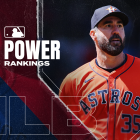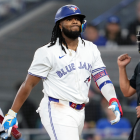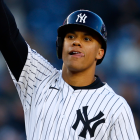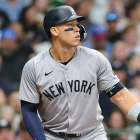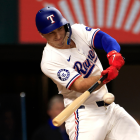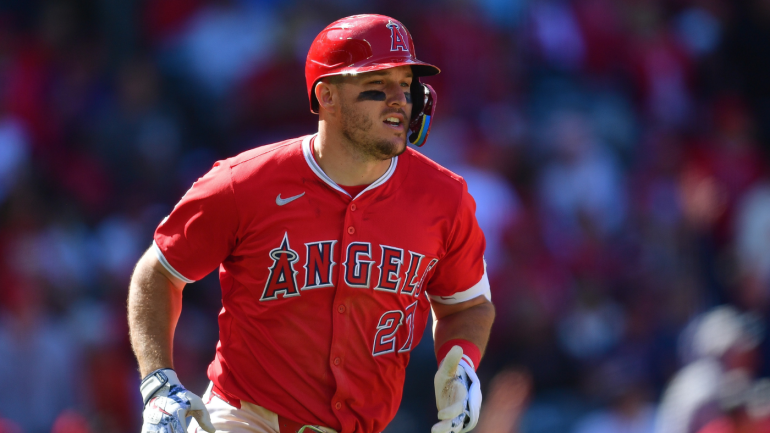
There used to be a rule of thumb among baseball writers that the season wasn't "real" until Los Angeles Angels star Mike Trout led the majors in Wins Above Replacement. It never took him long to climb the leaderboard, but once he did -- and he always did -- you could feel more confident in analyzing individual performances.
It's been a while since that guidepost was helpful. Trout's rash of injuries, plus former teammate Shohei Ohtani's historic brilliance, has made the latter more befitting of being the standard bearer. Despite what you might be expecting us to write next, Trout is not actually atop the leaderboard right now. He is pretty close though, sitting sixth on FanGraphs and tied for eighth on Baseball Reference. That's a result of him batting .290/.362/.710 (202 OPS+) with seven home runs and 10 RBI over his first 16 games.
Mike Trout with a two-run homer to left and the #Angels take a 2-1 lead in the eighth inning. It's his seventh of the year. pic.twitter.com/C0tVNjfMPw
— Rhett Bollinger (@RhettBollinger) April 16, 2024
With that in mind, we decided this would be the opportune time to dig in on Trout. What we found is that two notable things have changed about his game while one has remained the same. Scroll slowly with us while we reveal all, won't you?
1. Improved contact rate
Last August, we observed that Trout had made a philosophical shift to his game by prioritizing slugging over contact. Not only was he whiffing more frequently, he was pulling the ball more often. It wasn't too surprising of a development: the all-or-nothing approach to hitting has become MLB's house style.
If Trout's season to date is any indication, that might be changing.
Trout has significantly improved his contact rate, connecting so far on more than 83% of his swings. That would represent a new career-best figure if he's able to maintain it over the rest of the season. Additionally, he's nearly halved his overall whiff rate from last year. He's also improved his contact rate on two-strike pitches, lifting it from 65.5% to 80.7%. Trout, in turn, has seen his strikeout rate dip from 28.7% to 18.8%.
Observant readers might be thinking to themselves that this all sounds a bit like what Cody Bellinger did last year, when he authored his finest season in ages. That comparison works in another respect, too.
2. Different exit velocity
Part of what made Bellinger such a polarizing free agent was the effect his contact-heavy approach had on his exit velocity. Simply put, he wasn't hitting the ball with the force you would expect from someone who once launched 47 home runs.
Trout is following a similar pattern. His average exit velocity is down more than 2 mph in 2024 and his hard-hit percentage (that is, the share of batted balls with a 95 mph exit velocity or greater) has declined from 51.9% to 36.7%. That's the difference between being in the top 5% of the league or being around the league-average mark.
deep in his bag like a grandma with a peppermint 👝#RepTheHalo pic.twitter.com/P6s9D33hwj
— Los Angeles Angels (@Angels) April 10, 2024
Intuitively, it tracks that a heightened emphasis on making contact would result in a lower average exit velocity; you're probably employing your B-hack more often, resulting in more squibblers, flares, and dumps.
The difference between Trout and Bellinger is that Trout is still showing top-end power. He's already clobbered two balls over 110 mph, including one that clocked in over 113 mph; Bellinger's peak last season was 109.2 mph.
That's part of why, if we had to guess, we suspect Trout will see his aforementioned hard-hit percentage improve over the coming weeks. There's simply too much strength in his swing for him to be hitting the ball hard at a league-average rate.
As for that part of Trout's game that hasn't changed ....
3. Disciplined approach
A few years ago, some coach told a reporter that he was showing heat maps of Trout's swing rate to a young hitter to educate them on making better decisions. We would love to share the specifics of that story, but Google was unhelpful in uncovering it. As such, you'll have to take our word for it. Besides, we don't know that the finer details matter here: we suspect many coaches have used Trout as the model.
Trout, as a rule, doesn't swing very often. When he does, he swings at strikes. And, when he's in an early count -- say fewer than two strikes -- he'll look for one pitch in one area. If he gets it, he'll unleash; if he doesn't, he'll bide his time.
If you think about Trout's approach too much you'll become convinced hitting is that simple. Right, and Beethovan just tapped some keys.
Anyhow, Trout remains incredibly disciplined. He's sporting his lowest swing rate (42.3%) and chase rate (18.2%) since the 2021 season. His swing rate heat map in zero-strike counts hasn't achieved the same orderly look of those earlier in his career, when there was one neat little glowing area, but it still informs that he has a few favorite spots he likes to hunt and he otherwise doesn't bother:
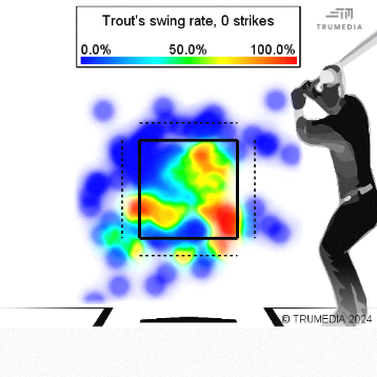
Take Trout's vision (and we mean that in multiple senses) and combine it with a renewed focus on making contact (while maintaining displays of immense raw strength). What do you get? A white-hot start to the season that has us remembering that Trout still has it.














